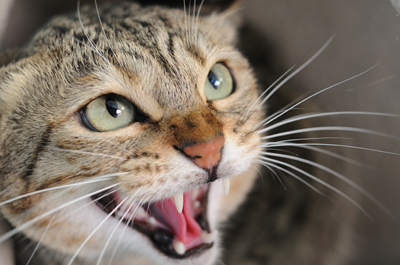
Unfortunately, feline aggression is not well understood or handled appropriately. An important first step in dealing with this frustrating issue is to understand the behavior. Learning why a cat lashes out can help pet parents deal with the issue patiently and properly.
In this post I’ll be covering the five basic types of aggression in cats.
Pain- or Health-Related Aggression
A cat who is experiencing pain or ailing may exhibit aggressive behavior, so it’s vital that your first stop be a trip to your vet, especially if what you’re witnessing is a recent change in behavior. Medical conditions that can cause pain and aggression include abscesses, dental disease and arthritis. Additionally, hyperthyroidism is associated with increased aggression in older cats. Alleviation of underlying medical conditions can often resolve the aggressive behavior.
Play Aggression
This form of aggression is typical of young cats and kittens. You can recognize play aggression by the feline’s posture: stalking or crouching like a lion, lashing the tail from side-to-side, especially when their pupils are dilated. As unsuspecting “prey” passes, whether it’s your dog or your spouse ... pounce! The cat who attacks your ankle and then disappears in a flurry of fur isn’t trying to maim you - he’s playing, albeit aggressively.
The best way to address play aggression is integrate a toy, such as a cat fishing pole or a laser pointer, into play sessions. These toys serve a dual purpose - they will hold your cat’s attention while burning off excess energy and keep your hands out of the “strike zone”. A stuffed sock can provide the perfectly-pouncible object. If additional measures are required to curb the behavior, consider blocking access to your cat’s favorite stalking places or use a noise deterrent, such as shaking a can full of coins. Remember that you must use a noise deterrent within the first few seconds of the inappropriate behavior for it to be effective. Never let your cat, even when he is a cute kitty, view you as an acceptable chew-toy. You might also trim her nails to minimize the “ouch factor” (here’s a video that shows you how).
Fear Aggression
When a fearful cat encounters an unpleasant situation, such as the veterinary office, he will likely take steps to protect himself. Fear clues include crouching with tail and legs tucked under, hissing and baring teeth, flattened ears, dilated pupils and fur standing on end. If your cat is fearful, it is important to identify and avoid, if possible, the thing triggering the fear. To overcome fear aggression, you can try to desensitize your cat to the fear-inducing object by keeping it at a distance and rewarding your cat with treats for non-aggressive behavior. Also, try to minimize stress in a fearful feline’s home environment. If your cat is completely out of control, have your veterinarian refer you to a behavioral specialist who can work with you and possibly prescribe medications to get your cat through the rough spots.
Redirected Aggression
I like to refer to this type as “innocent bystander aggression”. Redirected aggression typically occurs when a cat is aroused by one stimulus, such as a bird outside, when another pet or person intervenes. A cat exhibiting redirected aggression can be staring at something while growling and pacing with a lashing tail and dilated eyes. Avoid this cat until he has calmed down because interaction can lead to injury. If you can identify the stimulus that sets off your cat, you may be able to prevent the aggression. If it’s an external stimulus for an indoor cat, try using sticky tape or window blinds to prevent him from perching on windowsills. This, coupled with motion-activated lights (or sprinklers) to discourage outdoor visitors, could end the behavior. If your cat is aroused for an extended period of time, you can herd him with a thick folded blanket to a “time out” room equipped with food, water and litter. After he becomes calm, reward him with loads of attention.
Overstimulation
Similar to redirected aggression, overstimulation usually occurs when you are petting your cat and out of the blue they grab you and sink their teeth or claws into you. For highly reactive and vivacious cats, even a single long stroke down the spine can elicit an aggressive reaction. The key here is to recognize the warning signs: when the tail starts twitching, stop petting. Restrict your affections to areas that your cat enjoys, such as behind the ears or under the chin. If your cat grabs you, try not to overact; in fact, if you can, simply freeze … they will usually calm down quickly and let go.
If you take-away anything from this article, I hope it’s to never, ever hit a biting or scratching cat. Physical punishment, even a light rap on the nose, can increase fear and anxiety, potentially worsening the aggressive behavior. With time and patience, you can turn even the most claw-happy kitty into a loving companion.
Thank you for all you do to make the world a better place for companion animals,
Dr. Jane








 RSS Feed
RSS Feed




